October 05, 2009
Night Tiger Roars on Monday
As the week begins with a cool, crisp New England morning, we're hunkered down in The Workshop doing what we enjoy. As Dave and the guys in the woodshop prep the whitewood for the paint room, Todd is tackling the leveling on a Talladega with a special finish for a special client.
| 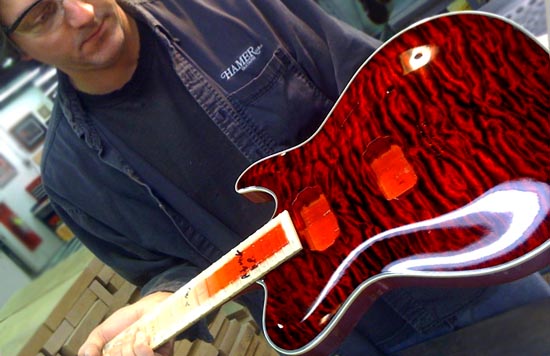
|
The quilt maple has been finished in a color we've dubbed Night Tiger, and even with its deep hue it retains the iridescent movement within the figure that our finishes are known for. The guitar is rimmed with multi-ply binding that looks great against the dark cherry color. It's going to be a great week in the Workshop!
| 
|
|
October 07, 2009
Plenty of Workshop Action
|
|
As the week progresses, there's plenty of chips flyin' in The Workshop. At one end of the room Todd is working on set-up of a left-handed Korina Special with a wrap around Tone Pros bridge. At the extreme opposite side of the shop Dave is fabricating the neck for a Standard 12-string bass.
This one has a rockin' quilt top and a matching quilt headstock which is in the shot above. I asked Dave to take some photos of the process so that we can show you how we take a slice out of the same billet of maple for the headplate. It's a pretty cool little detail that we like to do on our guitars. I'll put that up a little later.
| 
|

| Meanwhile somewhere in between the two extremes, here I am leveling the sides on the quilt-topped Studio we featured a few weeks back. Hand blocking the finish between coats is essential to our process for a couple of reasons. It takes the orange peel out, it keeps the finish thin and it also opens up the lacquer to let more solvents escape before trapping them with additional coats. I can't wait to show this one to you when it gets buffed!
|
|
October 12, 2009
Genuine Materials for Genuine Guitars |
|
Another week is upon us as we get on with the business of creating genuine and authentic American instruments. We like to use premium materials for their beauty and depth as well as their functionality. This morning Dave is trimming a neck with mother of pearl pieces—the biggest ones he can find. In this case, it borders a black ebony fingerboard and matching ebony headstock faceplate.
You can see the finished effect on the headstock curve at the bottom of the photo. Take a close look and you'll notice that the curved piece there is so long that you can't even see the end here. Think about how large the blank had to be in order to cut that curved piece from it. The easy way out is to use a bunch of small pieces and just angle them one-by-one around the curve. But that wouldn't be our way. Our clients are buying the effort not just the effect. Most people wouldn't know the difference, but we're not making these instruments for them.
| 
|
|
Another place where we spend more time and money is the string nut. Reclaimed and fossilized Russian ivory has a depth and glow that is far beyond bone or synthetic materials. Not only is it cherished because it is rare and beautiful, it has a hardness and lubricity that helps the string slide through. Here, Todd has just finished setting up a Newport with a Brazilian rosewood fingerboard. We use a graduated spacing that increases as the string gauges increase. Your fingertips sense the space between the strings, not the center of the string. That's why or guitars feel so friendly to play. As always, it's the little things that add up.
| 
|
|
October 28, 2009
Hamer Monaco Graces Keb' Mo' CD Cover
|
|
Regular readers of this blog will recall Keb' Mo's visit to the workshop. He'd already been a convert to Hamer, having comissioned a pair of Monacos after his first taste of a Korina Newport.
Originally outfitted with Lollar P90s, Keb found the noise level a little too much for his taste so he upgraded the guitar with a set of hum-cancelling Duncans. It didn't take long for "Big Red" to become his main stage and recording guitar.

| 
To our delight we discovered that Keb' has a new CD out featuring some live tracks as well as new studio material. We're certainly flattered to see "Big Red" on the album cover too!
Thanks buddy, we're proud to be a part of your team.
|
|
|
November 02, 2009
Monday... So Many Possibilities
Some folks dread Monday, but not us in The Workshop. As the beautiful New England fall sunrise burns the fog off the sparkling river outside our shop door, we're reminded of the possibilities we're handed each week. Can't wait to see what's in store.
Here's the fly fishing nirvana just outside our window—like living in a watercolor painting.
| 
|
|
November 03, 2009
More Keb' 'n' Monaco
Couldn't resist showing this surprise inside the new Keb' Mo' CD. Now I've got to get back to work.
| 
|
|
November 11, 2009
Wednesday Workshop Custom 12 String Bass |
|
As the mornings get darker and the air gets chillier, we find the guys engrossed in their work. Dave is putting the string nut blank on the twelve-string bass that we saw earlier.
We use a black material that we call Lubritrak. It's a tough, slippery material that allows the strings to glide smoothly through the slots. We pioneered the idea of a self-lubricating nut with the introduction of this material in the early 1980s. It works great for tremolo guitars too.
| 
|
After he bonds it down, Dave will file the nut blank to the proper width, height and shape. The next step is to stamp the serial number into the back of the headstock with a press. Dave gets the next available number from the book and loads the press with the stamping dies.
| 
|
As Dave pulls the lever down firmly, the dies press the number into the wood. In this case, it's a maple neck. The second line will be the letters U. S. A. because that's what we're all about.
The bass is now well on its way, but some of you are probably wondering what this twelve-string bass business is all about.
| 
|
Thirty Two years ago, bassist Tom Peterson threw in the towel trying to get his Hagstrom 8-string bass to function properly. Cheaply made, with only four bridge saddle for eight strings and a thin, flexible neck, it just wasn't cutting it for Tom. When he approached us, first to improve the Hagstrom, then to build a replacement—we thought it was a fine idea. When things escalated to twelve strings, we had our doubts.
| 
|
|
Tom's idea was to create an instrument based upon the ancient Tiple—a guitar-like instrument with four courses of three strings each. Each course, or group, would have a standard bass string as the root and two more strings tuned in unison one octave higher. Tom's band, Cheap Trick was basically a trio with a singer, and the big sound he anticipated would be perfect to fill things up and act as a de-facto rhythm guitar as well as a bass.
The Tiple made its way here from Spain by way of Columbia as early as the sixteenth century. Tiples were made by many builders in the US such as Martin (pictured right) and Regal, in the early part of the last century. To be honest, we thought that the force of twelve strings on a bass would compromise the neck. We negotiated Tom down to Ten strings for the first whack at it. The plan was to triple the top two courses and use the standard eight-string, double configuration for the lower two courses.
| 
|
Thus, in 1977, the first Hamer multi-string bass was developed and built. It wasn't as easy as just going out and buying the parts—they had to be made. I designed a bridge and tailpiece based upon the Thunderbird hardware, but with eight individual saddles so that Tom could intonate the octave strings separately from the low ones. I found a guy with a small machine shop to help make it, and then drove it over to the chrome plater down the road. These are still the guys who make them today! The bridge was a major improvement over original eight string. Incidentally, we constructed an eight-string electric mandocello for Rick Nielsen at the same time, and here's a photo of the two instruments together at the time of completion.
Tom took that first ten-string on the road, and when it stood up to the rigors of touring, it was time to make the world's first twelve-string bass. But that wouldn't even be enough for Tom, but that's a story for another time.
| 
|
|
November 12, 2009
Quilting for Comfort on a Cold Day |
|
It's getting cold here in rural New England, witnessed by the field jackets stuffing the coat rack just inside the workshop door. Inside, it's warm and a pleasant humidity—perfect for guitar building. Just the same, if Tom feels a little chill, he can cover up with a nice quilt like this one. Now doesn't that warm your heart?
If this wood looks familiar, it's because the maple top is from a nice batch from the same tree that yielded the one Tom made a few weeks back. If you are the new owner of this guitar now you know that there's a fraternal twin sister out there someplace. Will they ever meet?
| 
|
|
November 16, 2009
This Wheel's On Fire |
|
Todd has finished blocking out the Nightfire Talladega and has it on the wheel this morning. He started the third and final sanding with 400p sandpaper, and gradually reduced the grit step by step until he finished up with a micron paper that leaves the lacquer hazy but almost glossy. The next step is to use a yellow Menzerna buffing compound on a cotton wheel.
We use an 18" diameter wheel with an rpm of 1100. We calculate Todd's "feed" speed at about 25 ft/min. which gives us a face speed of about 5200 ft/min. By listening to the sound of the wheel against the work, Todd can vary his pressure accordingly to control heat buildup. Typically, we see a temperature of about 150 degrees F. By heating the lacquer, we're actually moving it around and smoothing out the scratches. Too much pressure and the finish will melt and ripple when it cools. Not enough pressure and the haze doesn't burn off.
In about an hour Todd will be ready to go to the hand polish and seal the finish. We'll wait a couple of days to see how the finish settles out before going back to do our final inspection and final wax. It won't be long now!
| 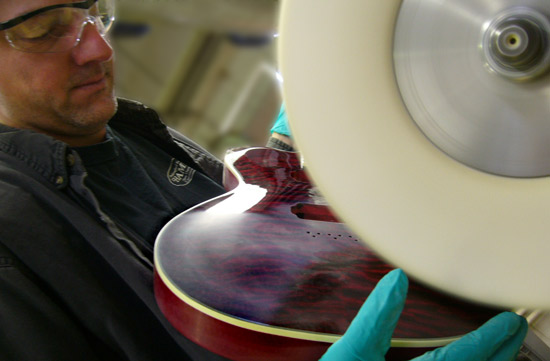
|
|
November 30, 2009
NightFire Talladega on the Wing
|
|
After a nice Thanksgiving break, we're back in the workshop and doing damage like always. There are lots of fun projects in house right now, some of which we'll be looking at shortly. But right now, let's roll the clock back to just before the holiday. Our Talladega with the NightFire finish was being buffed out and then assembled on Todd's bench.
In went the Double-D pickups, four-way switch, volume and tone controls.
| 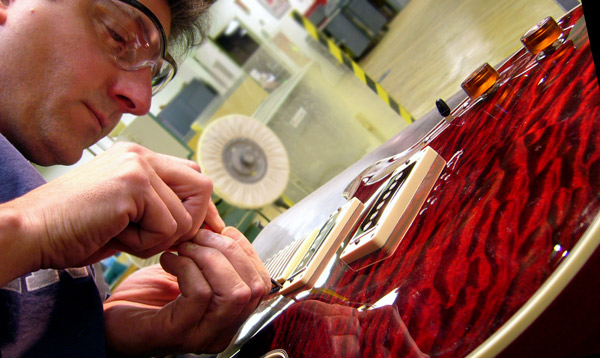
|
In this shot you can see the matching headstock overlay—a slice of the same maple that's on the top of the guitar, and the abalone faceplate inlay. Even the tiny "USA" inlays are individual pieces! This order called for Schaller tuners, still the highest quality, hands-down. Our client wanted some impressive binding, and Dave came through in a big way. It's hard to do properly, laying each strip on over the next, but that's the way we do it, instead of using pre-laminated plastic with the stripes already in them.
| 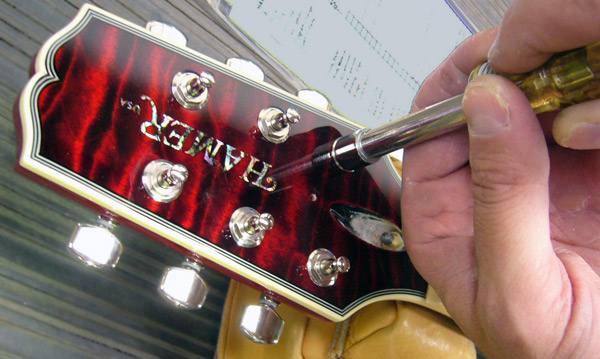
|
Next, Todd hand wired the electrical components, all of which have been specially sourced to our specifications. Old-school cloth covered wire, custom-taper potentiometers by CTS, and the Sprague "orange drop" capacitor get hooked up inside the control cavity using lead-free solder. The whole deal is sprayed with a nickel based shielding paint that we import from Belgium—it's the best there is. After sealing things up with our anodized aluminum back plate door, Todd cut the nut and strung it up.
| 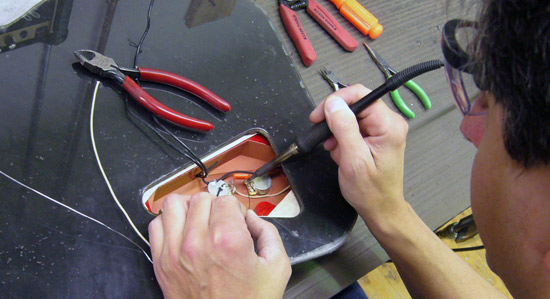
|
In the set-up room we set the action, neck relief (.010" at the 8th fret) and then play test the guitar for a while. It's at this point that pickup heights can be set to balance the tone and output. I like to put the neck pickup down a bit lower than usual on the bass side with the Double-Ds. This cleans up the bottom end and keeps it from being too flubby. At the same time keeping the strings close on the higher strings fattens them up relatively. The bridge pickup has quite a bit of magnetic pull due to the large alnico polepieces and a large copperplated steel plate underneath—that how it gets its ultra-twang. You have to be careful not to get it too close to the strings or ghost tones can occur, which make the guitar hard to intonate.
| 
|
Here's a nice shot of the ivory nut and the abalone Victory inlay at the first fret, another nice option. Todd has done a great job slotting the ivory. We use a graduated spacing that gets wider as the strings get thicker. Your fingertips feel the space between the strings, so our method evens that out as opposed to evenly spacing the centers. The result is the trademark Hamer feel that makes this Talladega such a joy to play right out of the box.
| 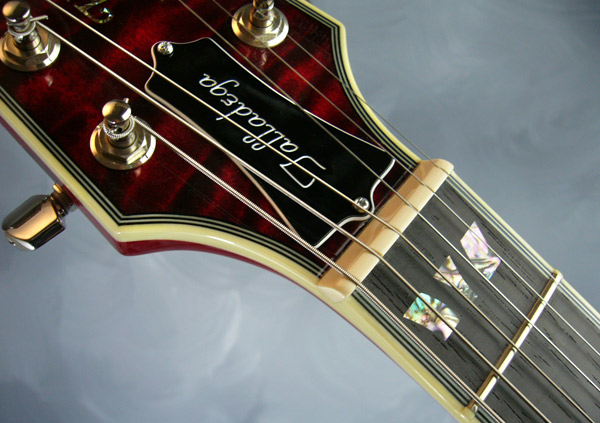
|
|
Previous Months
| Next Month
|
